In the Tech Industry, AI Can Help Companies Outsmart the Competition
Posted by | Fuld & Company
How Small-and-Medium Sized Businesses and Large Enterprises Should Introduce AI to the Workplace
In Part 2 of this series, Fuld & Company explores the implications of using AI to Retain Talent in the Technology Field
AI and the Workplace Blog Series, Part 2
The scarcity of tech talent in a growing, rapidly evolving field puts pressure on companies—of all sizes—to consider the resources and tools available that help them to recover from damage caused by a lack of quality talent. For some, the answer is found in Artificial Intelligence (AI). AI may seem like a futuristic solution for smaller companies wondering how they can attract new hires, but the reality is AI is already in many companies’ proverbial backyard. While AI is stereotypically thought of as a tool “from the future” that leads to self-driving cars and robots in the workplace, many businesses are already using AI to support menial functions and increase efficiencies—which can enable a better line of defense in the war on talent.
Instead of companies fearing that AI is a replacement for jobs, as we mentioned in the Part 1 tech talent piece in this series, company leaders should view AI as a necessary application that should be leveraged for much-needed human resources capabilities.
AI Helps SMBs to Stay Competitive
Labor-skills shortage in industries like tech could reach numbers in the millions by 2030, and as such, attracting talent is not going to get easier. In industries like technology, where the unemployment rate is typically low, talent becomes a large issue if not addressed and handled using the proper tools. For further consideration, tech giants like Amazon have strong brand-strength and recognition in the marketplace—and many potential hires gravitate towards the open positions at the companies that bolster their resumes with impressive projects and name-brand titles.
As such, it can be daunting for SMBs to fathom the idea of competing for the same candidates as the big players or retaining their key employees long-term.
However, not all candidates will get hired by big corporations, so there are opportunities to attract talent that will both promote and support SMBs’ bottom line. It’s true that SMBs may eventually invest time and resources into their HR functions, but many fail to realize AI is already integrated into their workplaces and can be effectively used to increase efficiencies, retain applicant data and interact with potential hires, digitally.
SMBs may assume that AI technology is a costly endeavor better left for big tech-giants like Amazon and shy away from it all together, however, avoiding AI integration in a highly competitive job market, especially in the technology industry, could put SMBs at risk for losing out on valuable and essential talent. Leaders of SMBs should evaluate how they can effectively use their existing AI to fight their battles on the war for talent—and one such technology filters candidates based on a scoring system.
Modern HR platforms use AI to test technically-oriented candidates and to provide companies with a basic idea of a candidate’s capabilities in the early stages of hiring. Though testing platforms cannot guarantee that the best candidates receive the highest scores, the act of filtering out blatantly unqualified candidates allows a hiring department to better narrow focus.
Further, when the threat of employee poaching is real, and SMBs consider companies like Google, Amazon and Facebook seducing potential hires, they want to consider how they can garner data on attractive hires and use that data to their benefit.
An Applicant Tracking System (ATS), is used for recruiters to organize interested candidates within a central program—this can be an essential asset to SMBs looking for highly competitive tech talent. While not inherently AI or ML (machine learning) based, it’s become increasingly common to pair ATS’ with an AI component to save time without sacrificing quality.
ATS’, can streamline many digital moving parts that typically get tangled up for HR managers –ATS’ help match candidates from the talent pool with a company’s wish list and presents a more seamless transition across the process; from analyzing digital applications to arranging candidate interviews. While these actions can be performed by an HR staff, ATS’ are a more robust tool in a company’s hiring kit that provide data and insights–leading to more informed hiring decisions. Informed hiring decisions are key to enabling growth, especially for companies in industries like technology that experience high turnover due to competition in the job market.
Further, ATS data helps businesses make better hiring decisions as the data sheds a light on candidates and their respective backgrounds, and tracks those who have had a successful experience with the company throughout the entirety of the hiring process.
HR Tech Integrated in a Larger Capacity for the Big Players
While SMBs can focus on easily attainable AI, it’s important for large enterprises to integrate AI as a long-term time savings option. When large enterprises can focus on the business, instead of involved HR processes, they’re able to significantly focus on growing the talent they’ve accrued.
Although useful for SMBs, AI is typically designed to assist a small HR team or single HR representative—but when used with large HR machines, AI tools increase efficiencies significantly and provide rich data that helps the enterprise evolve in a forward-moving direction. While small-to-mid sized businesses may have some time and leeway to weigh their options when it comes to investing in up-and-coming technology, enterprises need to act while the AI renaissance is emerging. Google, Amazon, Microsoft, Facebook and IBM are just a few of the companies that are integrating AI into their strategic visions. In fact, Facebook messenger is just one application powered by AI.
It’s clear large tech companies are not only using AI for hiring, but are also using AI to improve their businesses, thus making them more attractive to the talent pool. Further, AI skills themselves are one of the fastest growing desired proficiencies in the market, with more businesses adding AI to their operations suites.
Large enterprises have the upper hand in the hiring landscape today, as they have experienced more with AI applications to a further degree than SMBs. For example, large companies have leveraged AI to lead and analyze interviews with candidates, conducted in a video format much like Skype. AI will assess facial expressions and word choices throughout the interview based on carefully constructed algorithms. For some HR teams, the ability to conduct on-demand interviews through AI, can significantly increase efficiencies. However, the lack of human connection and relationship building that naturally stems from an in-person interview becomes lost, which causes some candidates to sour on the experience. While large enterprises may have the upper hand in the hiring landscape today, it is critical to remember that striking a balance between AI’s efficiencies and the emotions brought forth by human beings is key for solid AI adoption across the enterprise. Relying too much on an AI to perform the role of a recruiter or hirer can result in a jarring experience for potential candidates.
Key Considerations for Employing HR Tech
Talent, well-versed in AI, can be a more valuable investment than just a-la-cart AI tools or small-scale AI capabilities. As we balance the growth of technology with the risks of interfacing with aggressive competition to retain talent, it’s key for all businesses to aim for the “low hanging fruit” according to Mindtree’s Dr. Satya Ramaswamy, a digital business expert.
As AI gains momentum and becomes increasingly integrated in the workplace, it’s important for business of all sizes to still consider —and plan for– potential hurdles. Even as hiring evolves to include AI, employment and hiring are traditionally riddled with challenges and could be worsened by the introduction of complex algorithms that are still in development. According to a recent HBR survey, AI applications, when used to increase efficiencies, grant significant benefits to employees and employers without removing jobs or complicating processes.
As the survey data reveals, AI is best-used in capacities across the enterprise or in back-end applications, while humans best serve as AI’s overseer or wielder.
To ease into an introduction to AI, business should focus on repetitive tasks as those are the “bread and butter” of the technology’s capabilities. However, it’s critical companies acknowledge that AI does not conform to a one-size-fits-all solution for each company. Industries are moving at different paces, and while it may be tempting to adopt every cutting-edge technology, it is more cost effective and strategic to spend resources responding to direct competition within the industry, first.
Overall, as AI makes its way into businesses of all sizes, company leaders should consider the delicate balance of personnel and technology to tweak an approach that fits their unique goals.
In part three we’ll divulge where we think AI integration is headed, and how businesses should approach it to advance in a landscape that is being shaped by digital tools.
Tags: Artificial Intelligence, Competitive Advantage, Competitive Strategy, Human Resources, Information Technology, Modern Workplace, Other Industries, The Race for Talent




















